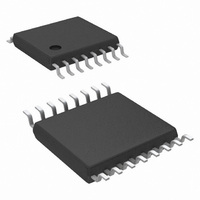LM20136MHE/NOPB National Semiconductor, LM20136MHE/NOPB Datasheet - Page 11

LM20136MHE/NOPB
Manufacturer Part Number
LM20136MHE/NOPB
Description
IC REG SYNC BUCK 6A 16-TSSOP
Manufacturer
National Semiconductor
Series
PowerWise®r
Type
Step-Down (Buck)r
Datasheet
1.LM20136MHNOPB.pdf
(22 pages)
Specifications of LM20136MHE/NOPB
Design Resources
LM20136 Design Spreadsheet
Internal Switch(s)
Yes
Synchronous Rectifier
Yes
Number Of Outputs
1
Voltage - Output
0.8 ~ 5 V
Current - Output
6A
Frequency - Switching
410kHz
Voltage - Input
2.95 ~ 5.5 V
Operating Temperature
-40°C ~ 125°C
Mounting Type
Surface Mount
Package / Case
16-TSSOP Exposed Pad, 16-eTSSOP, 16-HTSSOP
Power - Output
2.6W
Lead Free Status / RoHS Status
Lead free / RoHS Compliant
Other names
LM20136MHE
der of 100 kΩ or less. To avoid false tripping during transient
glitches the PGOOD pin has 16 µs of built in deglitch time to
UVLO
The LM20136 has a built-in under-voltage lockout protection
circuit that keeps the device from switching until the input
voltage reaches 2.7V (typical). The UVLO threshold has 45
mV of hysteresis that keeps the device from responding to
power-on glitches during start up. If desired the turn-on point
of the supply can be changed by using the precision enable
pin and a resistor divider network connected to V
in Figure 7 in the design guide.
THERMAL PROTECTION
Internal thermal shutdown circuitry is provided to protect the
integrated circuit in the event that the maximum junction tem-
perature is exceeded. When activated, typically at 160°C, the
LM20136 tri-states the power FETs and resets soft start. After
the junction cools to approximately 150°C, the part starts up
using the normal start up routine. This feature is provided to
prevent catastrophic failures from accidental device over-
heating.
FIGURE 1. Powergood Behavior
IN
as shown
11
both rising and falling edges.The powergood behavior for fault
conditions is illustrated in Figure 1
LIGHT LOAD OPERATION
The LM20136 offers increased efficiency when operating at
light loads. Whenever the load current is reduced to a point
where the peak to peak inductor ripple current is greater than
two times the load current, the part will enter the diode emu-
lation mode preventing significant negative inductor current.
The point at which this occurs is the critical conduction bound-
ary and can be calculated by the following equation:
Several diagrams are shown in Figure 2 illustrating continu-
ous conduction mode (CCM), discontinuous conduction
mode, and the boundary condition.
It can be seen that in diode emulation mode, whenever the
inductor current reaches zero the SW node will become high
impedance. Ringing will occur on this pin as a result of the LC
tank circuit formed by the inductor and the parasitic capaci-
tance at the node. If this ringing is of concern an additional
RC snubber circuit can be added from the switch node to
ground.
www.national.com
30053970











